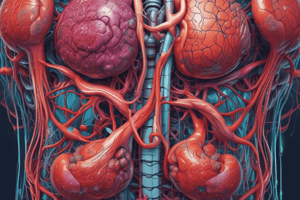Podcast
Questions and Answers
Which type of neuron is responsible for carrying signals from sensory receptors to the CNS?
Which type of neuron is responsible for carrying signals from sensory receptors to the CNS?
- Motor Neurons
- Interneurons
- Efferent Neurons
- Sensory Neurons (correct)
What is the main role of the Central Nervous System (CNS)?
What is the main role of the Central Nervous System (CNS)?
- Control reflex actions
- Coordinate voluntary movements
- Process information (correct)
- Transmit signals to muscles and glands
What is the main purpose of reflex actions?
What is the main purpose of reflex actions?
- To bypass the brain for quicker responses (correct)
- To facilitate voluntary movements
- To enhance sensory perception
- To increase motor strength
What role do agonist and antagonist muscles play in muscle coordination?
What role do agonist and antagonist muscles play in muscle coordination?
How does the cerebellum contribute to muscle coordination?
How does the cerebellum contribute to muscle coordination?
What is the primary function of negative feedback mechanisms?
What is the primary function of negative feedback mechanisms?
What is proprioception?
What is proprioception?
How do hormones interact with the nervous system?
How do hormones interact with the nervous system?
Which of the following describes the function of neurotransmitters?
Which of the following describes the function of neurotransmitters?
What can influence muscle strength during contraction?
What can influence muscle strength during contraction?
Study Notes
Nervous System Functions
- General Purpose: Coordinates body activities by sending and receiving signals.
- Components:
- Central Nervous System (CNS): Brain and spinal cord; processes information.
- Peripheral Nervous System (PNS): Nerves outside the CNS; transmits signals between CNS and body.
- Types of Neurons:
- Sensory Neurons: Carry signals from sensory receptors to the CNS.
- Motor Neurons: Transmit signals from the CNS to muscles and glands.
- Interneurons: Connect neurons within the CNS for processing.
- Reflex Actions: Fast, involuntary responses to stimuli; bypass the brain for quicker reactions.
- Neurotransmitters: Chemical messengers that transmit signals across synapses between neurons.
Muscle Coordination
- Skeletal Muscles: Voluntary muscles controlled by the somatic nervous system.
- Types of Muscle Coordination:
- Agonist and Antagonist: Muscles work in pairs; one contracts (agonist) while the other relaxes (antagonist).
- Synergist Muscles: Assist the prime mover in action.
- Role of the Cerebellum: Coordinates voluntary movements, balance, and posture.
- Motor Units: A motor neuron and the muscle fibers it controls; recruitment of motor units increases muscle strength during contraction.
- Proprioception: The body's ability to sense its position and movement, crucial for coordinating muscle activity.
Feedback Mechanisms
- Definition: Processes that regulate homeostasis through feedback loops.
- Types of Feedback:
- Negative Feedback: Reduces output or activity in response to changes; maintains stability (e.g., temperature regulation).
- Positive Feedback: Enhances or increases output; often leads to a specific outcome (e.g., childbirth contractions).
- Homeostasis Example: Regulation of blood glucose levels via insulin (decreases glucose) and glucagon (increases glucose).
- Role in Nervous System: Feedback mechanisms help the CNS adapt to changes, ensuring proper response to internal and external stimuli.
- Hormonal Feedback: Hormones interact with the nervous system, influencing responses and behaviors, such as stress responses through the hypothalamic-pituitary-adrenal (HPA) axis.
Nervous System Functions
- Coordinates body activities through signal transmission and reception.
- Central Nervous System (CNS) consists of the brain and spinal cord, acting as the main processing center for information.
- Peripheral Nervous System (PNS) includes all nerves outside the CNS, facilitating communication between the CNS and the body.
- Sensory Neurons transmit signals from sensory receptors to the CNS, allowing perception of stimuli.
- Motor Neurons convey signals from the CNS to effectors, such as muscles and glands, initiating movement or actions.
- Interneurons are found within the CNS, connecting various neurons for internal processing of information.
- Reflex Actions are quick, involuntary responses that bypass the brain, enabling faster reactions to stimuli.
- Neurotransmitters are essential chemical messengers that relay signals across synapses, playing a vital role in communication between neurons.
Muscle Coordination
- Skeletal Muscles are voluntary, under control of the somatic nervous system, allowing purposeful movements.
- Agonist and Antagonist muscle pairs work in concert; agonists contract while antagonists relax, facilitating movement.
- Synergist Muscles assist agonists during contractions, enhancing overall motor performance and efficiency.
- Cerebellum plays a crucial role in coordinating voluntary movements, maintaining balance, and ensuring proper posture.
- Motor Units consist of a motor neuron and the muscle fibers it innervates; increased recruitment of motor units leads to greater muscle strength during contractions.
- Proprioception refers to the body's awareness of its position and movement in space, essential for effective muscle coordination.
Feedback Mechanisms
- Feedback mechanisms are vital for maintaining homeostasis through regulated feedback loops.
- Negative Feedback processes reduce output or activity in response to internal changes, promoting stability (e.g., maintaining body temperature).
- Positive Feedback amplifies responses or processes, often culminating in a significant event (e.g., contractions during childbirth).
- Blood glucose regulation exemplifies homeostasis; insulin decreases blood glucose levels, while glucagon increases them.
- The nervous system employs feedback mechanisms to adapt to internal and external changes, ensuring appropriate responses.
- Hormonal Feedback involves interactions between hormones and the nervous system, affecting responses like stress management through the hypothalamic-pituitary-adrenal (HPA) axis.
Studying That Suits You
Use AI to generate personalized quizzes and flashcards to suit your learning preferences.
Description
This quiz covers the essential functions of the nervous system, including the roles of the central and peripheral nervous systems, types of neurons, and reflex actions. It also delves into muscle coordination, highlighting skeletal muscles and their interactions during movement. Test your knowledge on these fundamental biological concepts!




